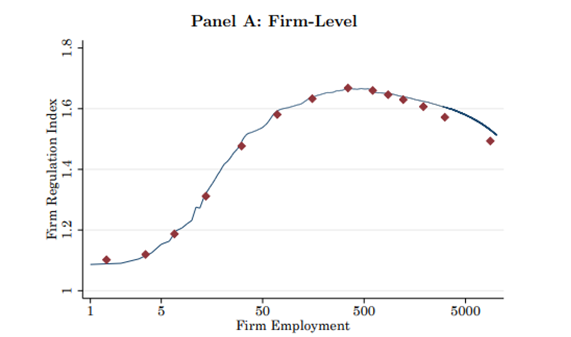Docket ID No. ATR-2025-0001
Download this public comment (PDF)
Introduction
I submit this comment in response to the request by the Anticompetitive Regulations Task Force of the United States Department of Justice for comments on laws and regulations that raise barriers to competition. The Task Force highlights the importance of reducing the undue burden placed on small firms by regulation and of allowing small firms to compete “on a level playing field with powerful corporations.”
The request for comments is part of the broader initiative of the Trump Administration to eliminate unnecessary and unlawful regulations through Executive Order 14192, Unleashing Prosperity Through Deregulation, and Executive Order 14219, Ensuring Lawful Governance and Implementing the President's “Department of Government Efficiency" Deregulatory Initiative. Section 2 part vii of the latter seeks to eliminate “regulations that impose undue burdens on small business and impede private enterprise and entrepreneurship.”
I support the goal of reducing the regulatory burden on small businesses. These firms comprise an important part of the economy, and regulatory costs often put them in a precarious financial position.
However, in order to encourage small businesses to compete with large corporations, it is not enough to reduce their costs of compliance. It is also necessary to change policies that give small businesses the incentive to stay small. I recommend that agencies interpret the Regulatory Flexibility Act, or if necessary, seek amendments to it, so that the lower regulatory costs given to small businesses are phased out more slowly as the businesses grow.
Analysis
Small firms play a vital role in the US economy. They provide a large fraction of employment and income, and contribute greatly to innovation.
Regulatory compliance imposes a bigger burden on small firms than on large firms. This burden impedes growth for small firms and makes them vulnerable to failure. Only 50 percent of small firms remain in the market after five years, and only 35 percent survive for 10 years. Research shows that regulations are associated with a higher failure rate for small firms, but not for large firms.
The negative impact of regulatory costs on small firms underscores the importance of the Task Force’s effort. Easing the regulatory burden placed on small firms would improve their financial position and reduce their risk of failure. However, to create a level playing field, and to make it more likely that small firms can grow and provide greater competition to large firms, it is also necessary to change policies that give small firms the incentive to stay small.
To help small firms, policymakers should adopt policies that lighten the regulations imposed on them from techniques such as regulatory tiering and exemptions. As firms grow, they face increasing regulatory burdens as these benefits are phased out. The prospect of facing higher regulatory costs can give small firms the incentive to stay small. Studies show that, if one looks at the size distribution of small firms, a disproportionately large number are just below the threshold at which they would lose regulatory relief if they expanded. In the U.S., public firms bunch around regulatory market capitalization thresholds, which is consistent with their avoiding growth that would result in higher regulatory costs. There is also evidence of discontinuities in firm size around thresholds in labor law enforcement in Italy and in France, and of a reduction in innovation around these thresholds in France. These studies provide examples of how regulatory thresholds may affect a firm’s incentive to grow.
In a major contribution to regulatory research, Trebbi and Zhang provide a detailed analysis of the distribution of U.S. firms’ regulatory compliance costs. They develop a measure of compliance costs based on the fraction of labor costs dedicated to regulatory-related tasks. Their results show that, as firms grow, the fraction of regulatory-related labor costs is increasing for small firms and decreasing for large firms. This inverted U-shaped distribution indicates that there are diseconomies of scale in regulatory compliance for small firms, and economies of scale for large firms.
Below is a reproduction of Panel A, Figure 5 from Trebbi and Zhang.
This graph shows that when small firms expand, they face increased costs of regulatory compliance until they reach the size of 500 employees, and beyond that these regulatory-related costs start to fall. At the peak, the fraction of labor costs devoted to regulatory compliance is approximately 40-50 percent higher than that of the smallest firms, but is also higher than that of larger firms. The inverted U-shape cost distribution indicates that the premature phasing out of regulatory tiering and exemptions for small firms creates hurdles for small firms that want to grow. This graph shows that simply lowering regulatory costs for small firms will not level the playing field. It is also necessary to flatten the curve so that regulatory costs do not increase before small firms reach the economies of scale in regulatory compliance enjoyed by large firms.

Implications
The results suggest that policy makers should be concerned not only with the burden that regulations impose on small firms, but also with how quickly their policies increase the burden as firms grow. To accomplish this goal, agencies should consider different tiers of “small” in applying the Regulatory Flexibility Act in order to scale the compliance burden to firms of different sizes. This may require an amendment to the Act. Specifically, they should design flatter regulatory tiers that allow small firms to reach the economies of scale in regulatory compliance enjoyed by large firms.
Lowering the regulatory compliance costs for small firms is an important goal, but to allow small firms to compete on a level playing field with powerful corporations, it is necessary to eliminate the regulatory hurdles they encounter along the way.

